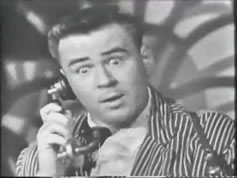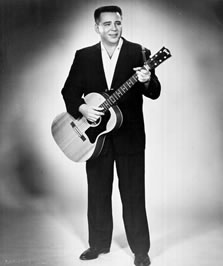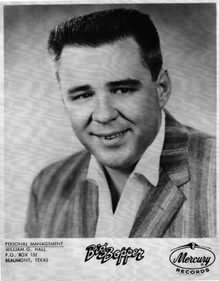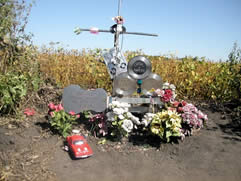The Big Bopper – Jiles Perry J. P. Richardson, Jr

The Big Bopper (1930-1959)
The Big Bopper (1930-1959), Jiles Perry “J. P.” Richardson, Jr., was an American musician, songwriter, and disc jockey, whose big rockabilly look, style, voice, and exuberant personality made him an early rock and roll star. He is best known for his 1958 recording of “Chantilly Lace”. On February 3, 1959, Richardson died in a plane crash in Clear Lake, Iowa, along with music stars Buddy Holly and Ritchie Valens, and pilot Roger Peterson. That event has become known as “The Day the Music Died” because it is so called in Don McLean’s 1971 song “American Pie”.

J. P. Richardson
J. P. Richardson was born in Sabine Pass, Texas, the oldest son of oil-field worker Jiles Perry Richardson, Sr. and his wife Elise (Stalsby) Richardson. Richardson had two younger brothers, Cecil and James. The family soon moved to Beaumont, Texas. Richardson graduated from Beaumont High School in 1947 and played on the “Royal Purple” football team as a defensive lineman, wearing number 85.Richardson later studied prelaw at Lamar College, and was a member of the band and chorus
Radio

Richardson
Richardson worked part-time at Beaumont, Texas, radio station KTRM (now KZZB). He was hired by the station full-time in 1949 and quit college. Richardson married Adrianne Joy Fryou on April 18, 1952, and their daughter Debra Joy was born in December 1953, soon after Richardson was promoted to supervisor of announcers at KTRM. In March 1955, he was drafted into the United States Army and did his basic training at Fort Ord, California. He spent the rest of his two-year service as a radar instructor at Fort Bliss in El Paso, Texas. Following his discharge as a corporal in March 1957, Richardson returned to KTRM radio, where he held down the “Dishwashers’ Serenade” shift from 11 am to 12:30 pm, Monday through Friday. One of the station’s sponsors wanted Richardson for a new time slot, and suggested an idea for a show. Richardson had seen the college students doing a dance called The Bop, and he decided to call himself “The Big Bopper”. His new radio show ran from 3:00 to 6:00 pm. Richardson soon became the station’s program director. Richardson is credited for creating the first music video in 1958, and recorded an early example himself.
Singer and songwriter
J. P. Richardson
Richardson, who played guitar, began his musical career as a songwriter. George Jones later recorded Richardson’s “White Lightning”, which became Jones’ first #1 country hit in 1959 (#73 on the pop charts). Richardson also wrote “Running Bear” for Johnny Preston, his friend from Port Arthur, Texas. The man who launched Richardson as a recording artist was Harold “Pappy” Daily from Houston. Daily was promotion director for Mercury and Starday Records and signed Richardson to Mercury. Richardson’s first single, “Beggar To A King”, had a country flavor, but failed to gain any chart action. He soon cut “Chantilly Lace” as “The Big Bopper”for Pappy Daily’s D label. Mercury bought the recording and released it in the summer of 1958. It reached #6 on the pop charts and spent 22 weeks in the national Top 40. Later that year, he scored a second hit, a raucous novelty tune entitled “The Big Bopper’s Wedding”, in which Richardson pretends to be getting cold feet at the altar.

Richardson – Death
With the success of “Chantilly Lace”, Richardson took time off from KTRM radio and joined Buddy Holly, Ritchie Valens, and Dion and the Belmonts for a “Winter Dance Party” tour starting on January 23, 1959.
On the 11th night of the tour (Feb 2, 1959), the musicians played the Surf Ballroom in Clear Lake, Iowa. That night, rock star Buddy Holly chartered an airplane from Dwyer Flying Service in Mason City, Iowa, intending to fly himself and his bandmates (Waylon Jennings and Tommy Allsup) ahead to their next tour venue in Moorhead, Minnesota, immediately after the show in Clear Lake.
The musicians had been traveling by bus for over a week, and it had already broken down twice. They were tired, they had not been paid yet, and all of their clothes were dirty. The chartered flight would allow them to avoid another arduous bus ride, arrive early before the Moorhead show, do their laundry, and get some rest. A 21-year-old local pilot, Roger Peterson of Dwyer Flying Service, had agreed to take Holly and his bandmates to their next destination.
The local weather forecast for the Clear Lake area was 18 °F that night with moderate gusty winds and light scattered snow, and Peterson was fatigued from a 17-hour workday, but he agreed to fly the trip. While Frankie Sardo went to meet the crowd, Holly went into one of the dressing rooms at the Surf Ballroom where he notified Allsup and Jennings that he had chartered a plane to take them to Fargo, North Dakota (which is directly adjacent to Moorhead, Minnesota). On a friendly wager, Ritchie Valens flipped a coin with Tommy Allsup for his seat on the plane, and Valens won the coin-toss. Meanwhile, J.P. Richardson was suffering from the flu and was complaining that the bus was too cold and uncomfortable for him, so Waylon Jennings voluntarily surrendered his seat on the plane to Richardson.
Upon hearing that his bandmates had given away their plane seats and were going to take the bus rather than fly, Holly joked, “Well, I hope your ol’ bus freezes up again.” Waylon Jennings jokingly replied, “Well, I hope your ol’ plane crashes.” Those words would haunt Jennings for the rest of his life.
For some unknown reason, shortly after take-off, the plane slammed into the ground at full-throttle about 5 miles outside Mason City in the middle of farm country. Possibly, Peterson lost his visual reference and thought he was ascending while he was actually descending; and it’s possible that he had mechanical problems and was attempting to turn back toward Mason City. For whatever reason, the right wingtip of the Beechcraft Bonanza first sliced into the frozen ground and sent the aircraft cartwheeling across a cleared cornfield at approximately 170 mph. The crash site was not discovered until well after sunrise, when the owner of Dwyer Flying Service conducted a brief search, following Peterson’s flight path. Because of the weather and remote location of the wreck, no ground team was able reach the crash site until later in the morning.
Richardson was survived by his wife and five-year-old daughter. His son, Jay Perry, was born two months later in April 1959. At the time of his death, Richardson had been building a recording studio in his home in Beaumont, Texas, and was also planning to invest in a radio station. He had written 20 new songs he planned to record himself or with other artists.
Jay Perry Richardson took up a musical career and was known professionally as “The Big Bopper, Jr.”, and performed around the world. He toured on the “Winter Dance Party” tour with Buddy Holly impersonator John Mueller on some stages where his father performed.
In January 2007, Jay requested that his father’s body be exhumed and an autopsy be performed in response to an alleged internet rumor about guns being fired aboard the plane, and Richardson himself initially surviving the crash; although Jay Richardson never divulged the name of the site where he had seen this rumor. The autopsy was performed by Dr. Bill Bass, a forensic anthropologist at the University of Tennessee, Knoxville. Jay was present with Dr. Bass throughout the autopsy and observed as the casket was opened; both men were surprised to find the remains well enough preserved to be recognizable as those of the late rock star. “Dad still amazes me 48 years after his death, that he was in remarkable shape,” Richardson told the Associated Press. “I surprised myself. I handled it better than I thought I would”. Dr. Bass’s findings indicated no signs of foul play. He was quoted as saying, “There are fractures from head to toe. Massive fractures …[Richardson] died immediately. He didn’t crawl away. He didn’t walk away from the plane”.
